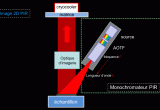The Mars2020 / Perseverance rover is the NASA's 2nd large-scale in situ exploration mobile robotic mission. The rover is based on the Curiosity except that the mission will have the ability to encapsulate Martian samples that could be recovered later by another so-called sample return mission. IAS was in charge of the calibration of the near-infrared IRS point spectrometer developed by LESIA and IRAP within the SuperCam instrumental consortium led by Los Alamos (USA). IRS is the first near-infrared spectrometer on the surface of Mars. It is one of Supercam's major iinstruments and allows to constrain the mineralogical composition of rocks and Martian soil. We also actively participated in the selection of the landing site.
Contact: François Poulet












